HA3011 Advanced Financial Accounting Report: Lease Accounting Analysis
VerifiedAdded on 2022/10/18
|13
|3605
|100
Report
AI Summary
This report analyzes the financial accounting practices of Transurban Group, focusing on the application of AASB 16 for lease accounting. It begins by identifying and describing key accounting concepts used by the company, such as the going concern concept. The report then details the changes introduced by AASB 16, contrasting the previous accounting standards for leases. The analysis includes specific examples from Transurban Group's annual report to illustrate the impact of the new standard. Furthermore, the report summarizes the key disclosures made by the company regarding its lease accounting practices, including transitional provisions and the effects of transitioning from AASB 117. The report emphasizes the implications of AASB 16 on the company's financial reporting, especially concerning the distinction between operating and finance leases and their impact on the balance sheet, income statement, and cash flow statement. The report concludes with an overview of the changes and their impact on the financial statements of Transurban Group.
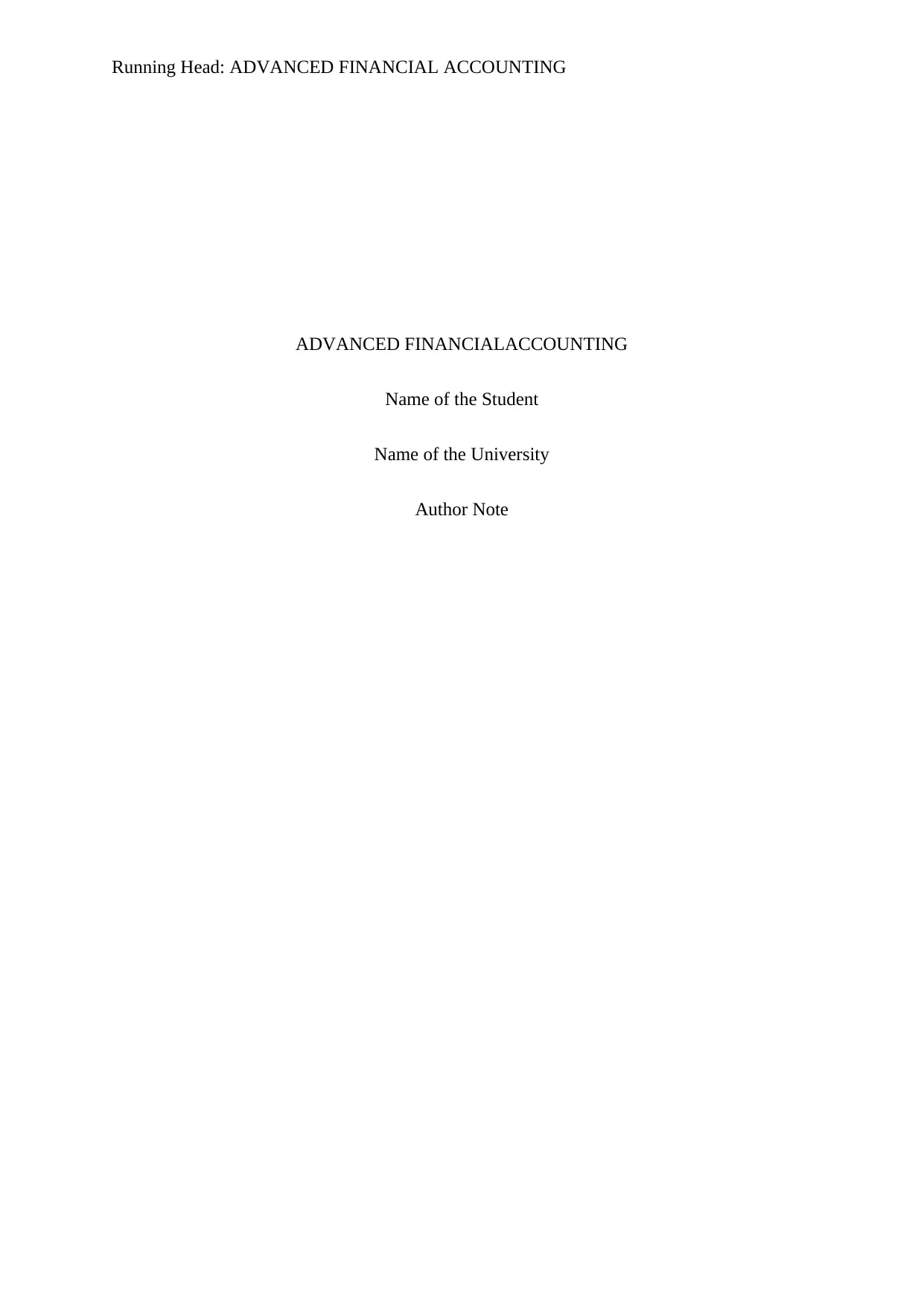
Running Head: ADVANCED FINANCIAL ACCOUNTING
ADVANCED FINANCIALACCOUNTING
Name of the Student
Name of the University
Author Note
ADVANCED FINANCIALACCOUNTING
Name of the Student
Name of the University
Author Note
Paraphrase This Document
Need a fresh take? Get an instant paraphrase of this document with our AI Paraphraser
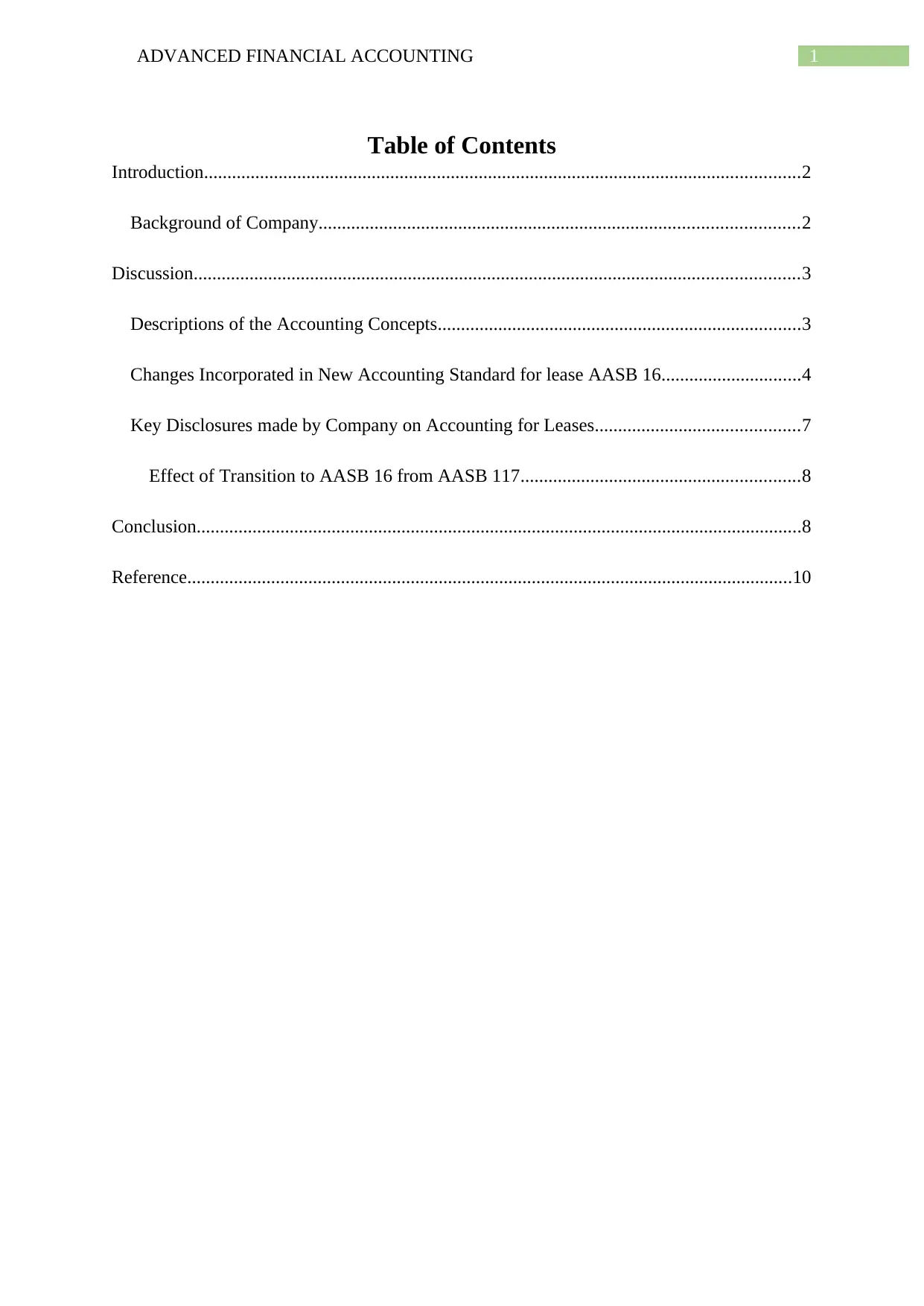
1ADVANCED FINANCIAL ACCOUNTING
Table of Contents
Introduction................................................................................................................................2
Background of Company.......................................................................................................2
Discussion..................................................................................................................................3
Descriptions of the Accounting Concepts..............................................................................3
Changes Incorporated in New Accounting Standard for lease AASB 16..............................4
Key Disclosures made by Company on Accounting for Leases............................................7
Effect of Transition to AASB 16 from AASB 117............................................................8
Conclusion..................................................................................................................................8
Reference..................................................................................................................................10
Table of Contents
Introduction................................................................................................................................2
Background of Company.......................................................................................................2
Discussion..................................................................................................................................3
Descriptions of the Accounting Concepts..............................................................................3
Changes Incorporated in New Accounting Standard for lease AASB 16..............................4
Key Disclosures made by Company on Accounting for Leases............................................7
Effect of Transition to AASB 16 from AASB 117............................................................8
Conclusion..................................................................................................................................8
Reference..................................................................................................................................10
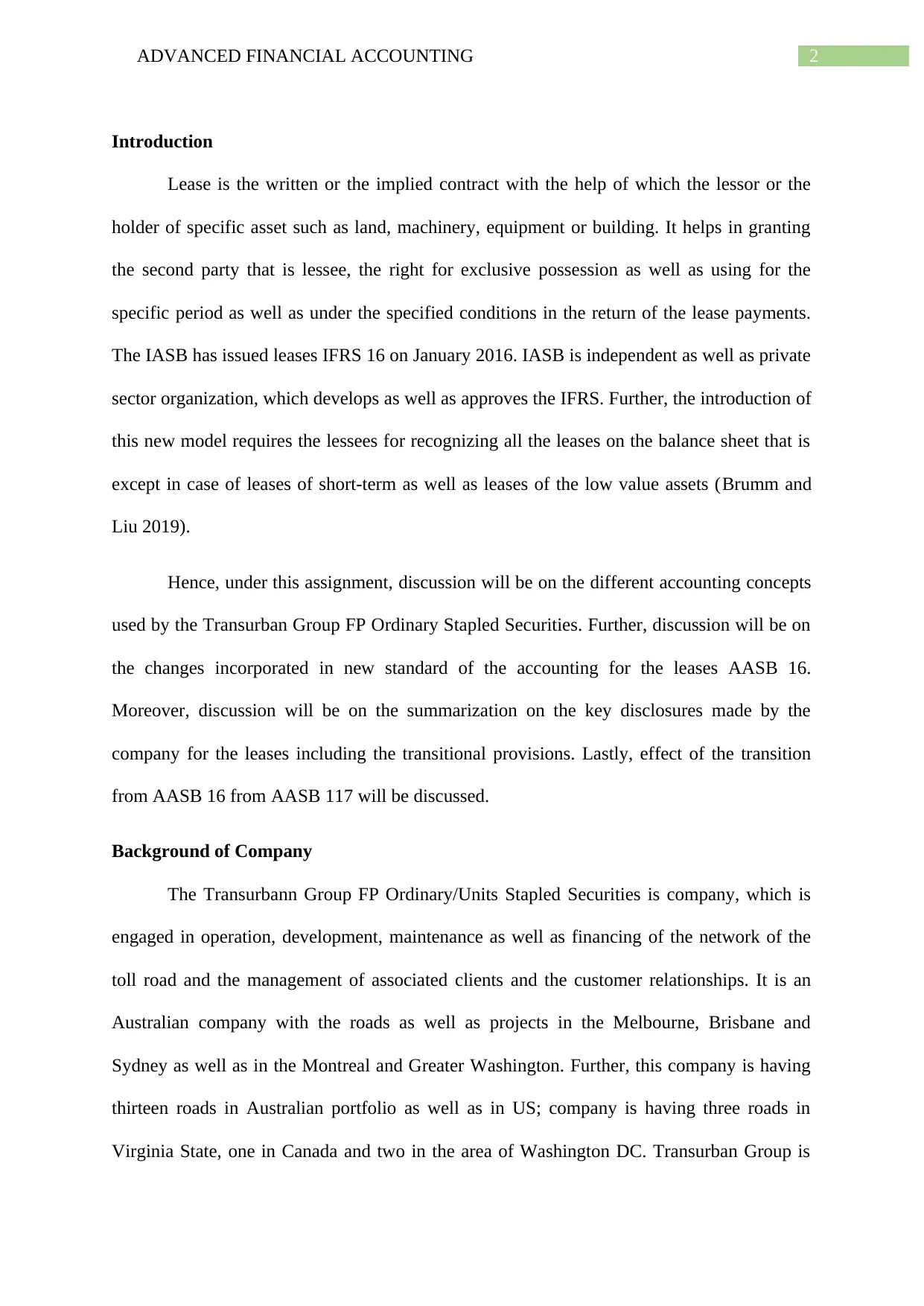
2ADVANCED FINANCIAL ACCOUNTING
Introduction
Lease is the written or the implied contract with the help of which the lessor or the
holder of specific asset such as land, machinery, equipment or building. It helps in granting
the second party that is lessee, the right for exclusive possession as well as using for the
specific period as well as under the specified conditions in the return of the lease payments.
The IASB has issued leases IFRS 16 on January 2016. IASB is independent as well as private
sector organization, which develops as well as approves the IFRS. Further, the introduction of
this new model requires the lessees for recognizing all the leases on the balance sheet that is
except in case of leases of short-term as well as leases of the low value assets (Brumm and
Liu 2019).
Hence, under this assignment, discussion will be on the different accounting concepts
used by the Transurban Group FP Ordinary Stapled Securities. Further, discussion will be on
the changes incorporated in new standard of the accounting for the leases AASB 16.
Moreover, discussion will be on the summarization on the key disclosures made by the
company for the leases including the transitional provisions. Lastly, effect of the transition
from AASB 16 from AASB 117 will be discussed.
Background of Company
The Transurbann Group FP Ordinary/Units Stapled Securities is company, which is
engaged in operation, development, maintenance as well as financing of the network of the
toll road and the management of associated clients and the customer relationships. It is an
Australian company with the roads as well as projects in the Melbourne, Brisbane and
Sydney as well as in the Montreal and Greater Washington. Further, this company is having
thirteen roads in Australian portfolio as well as in US; company is having three roads in
Virginia State, one in Canada and two in the area of Washington DC. Transurban Group is
Introduction
Lease is the written or the implied contract with the help of which the lessor or the
holder of specific asset such as land, machinery, equipment or building. It helps in granting
the second party that is lessee, the right for exclusive possession as well as using for the
specific period as well as under the specified conditions in the return of the lease payments.
The IASB has issued leases IFRS 16 on January 2016. IASB is independent as well as private
sector organization, which develops as well as approves the IFRS. Further, the introduction of
this new model requires the lessees for recognizing all the leases on the balance sheet that is
except in case of leases of short-term as well as leases of the low value assets (Brumm and
Liu 2019).
Hence, under this assignment, discussion will be on the different accounting concepts
used by the Transurban Group FP Ordinary Stapled Securities. Further, discussion will be on
the changes incorporated in new standard of the accounting for the leases AASB 16.
Moreover, discussion will be on the summarization on the key disclosures made by the
company for the leases including the transitional provisions. Lastly, effect of the transition
from AASB 16 from AASB 117 will be discussed.
Background of Company
The Transurbann Group FP Ordinary/Units Stapled Securities is company, which is
engaged in operation, development, maintenance as well as financing of the network of the
toll road and the management of associated clients and the customer relationships. It is an
Australian company with the roads as well as projects in the Melbourne, Brisbane and
Sydney as well as in the Montreal and Greater Washington. Further, this company is having
thirteen roads in Australian portfolio as well as in US; company is having three roads in
Virginia State, one in Canada and two in the area of Washington DC. Transurban Group is
⊘ This is a preview!⊘
Do you want full access?
Subscribe today to unlock all pages.

Trusted by 1+ million students worldwide
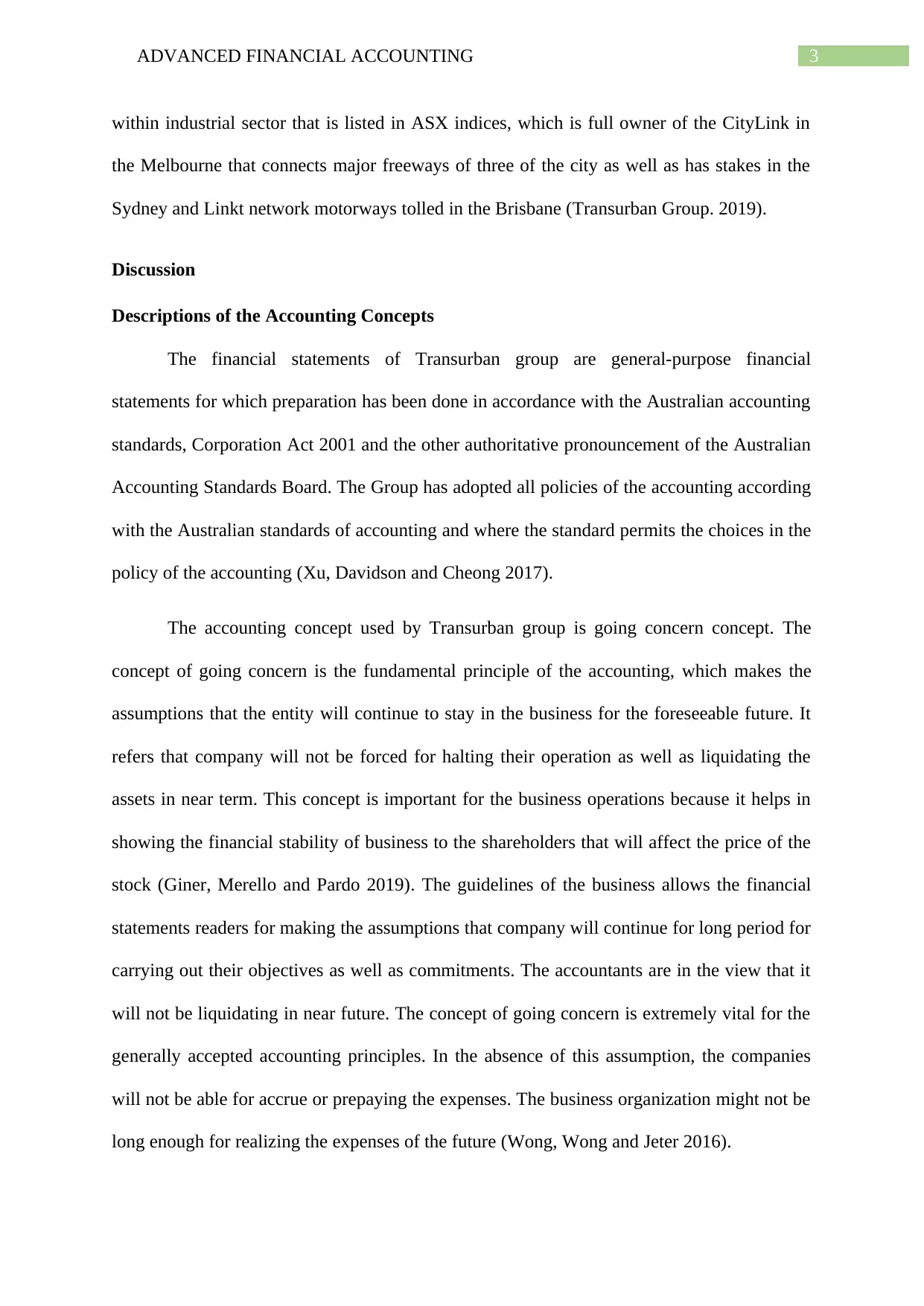
3ADVANCED FINANCIAL ACCOUNTING
within industrial sector that is listed in ASX indices, which is full owner of the CityLink in
the Melbourne that connects major freeways of three of the city as well as has stakes in the
Sydney and Linkt network motorways tolled in the Brisbane (Transurban Group. 2019).
Discussion
Descriptions of the Accounting Concepts
The financial statements of Transurban group are general-purpose financial
statements for which preparation has been done in accordance with the Australian accounting
standards, Corporation Act 2001 and the other authoritative pronouncement of the Australian
Accounting Standards Board. The Group has adopted all policies of the accounting according
with the Australian standards of accounting and where the standard permits the choices in the
policy of the accounting (Xu, Davidson and Cheong 2017).
The accounting concept used by Transurban group is going concern concept. The
concept of going concern is the fundamental principle of the accounting, which makes the
assumptions that the entity will continue to stay in the business for the foreseeable future. It
refers that company will not be forced for halting their operation as well as liquidating the
assets in near term. This concept is important for the business operations because it helps in
showing the financial stability of business to the shareholders that will affect the price of the
stock (Giner, Merello and Pardo 2019). The guidelines of the business allows the financial
statements readers for making the assumptions that company will continue for long period for
carrying out their objectives as well as commitments. The accountants are in the view that it
will not be liquidating in near future. The concept of going concern is extremely vital for the
generally accepted accounting principles. In the absence of this assumption, the companies
will not be able for accrue or prepaying the expenses. The business organization might not be
long enough for realizing the expenses of the future (Wong, Wong and Jeter 2016).
within industrial sector that is listed in ASX indices, which is full owner of the CityLink in
the Melbourne that connects major freeways of three of the city as well as has stakes in the
Sydney and Linkt network motorways tolled in the Brisbane (Transurban Group. 2019).
Discussion
Descriptions of the Accounting Concepts
The financial statements of Transurban group are general-purpose financial
statements for which preparation has been done in accordance with the Australian accounting
standards, Corporation Act 2001 and the other authoritative pronouncement of the Australian
Accounting Standards Board. The Group has adopted all policies of the accounting according
with the Australian standards of accounting and where the standard permits the choices in the
policy of the accounting (Xu, Davidson and Cheong 2017).
The accounting concept used by Transurban group is going concern concept. The
concept of going concern is the fundamental principle of the accounting, which makes the
assumptions that the entity will continue to stay in the business for the foreseeable future. It
refers that company will not be forced for halting their operation as well as liquidating the
assets in near term. This concept is important for the business operations because it helps in
showing the financial stability of business to the shareholders that will affect the price of the
stock (Giner, Merello and Pardo 2019). The guidelines of the business allows the financial
statements readers for making the assumptions that company will continue for long period for
carrying out their objectives as well as commitments. The accountants are in the view that it
will not be liquidating in near future. The concept of going concern is extremely vital for the
generally accepted accounting principles. In the absence of this assumption, the companies
will not be able for accrue or prepaying the expenses. The business organization might not be
long enough for realizing the expenses of the future (Wong, Wong and Jeter 2016).
Paraphrase This Document
Need a fresh take? Get an instant paraphrase of this document with our AI Paraphraser
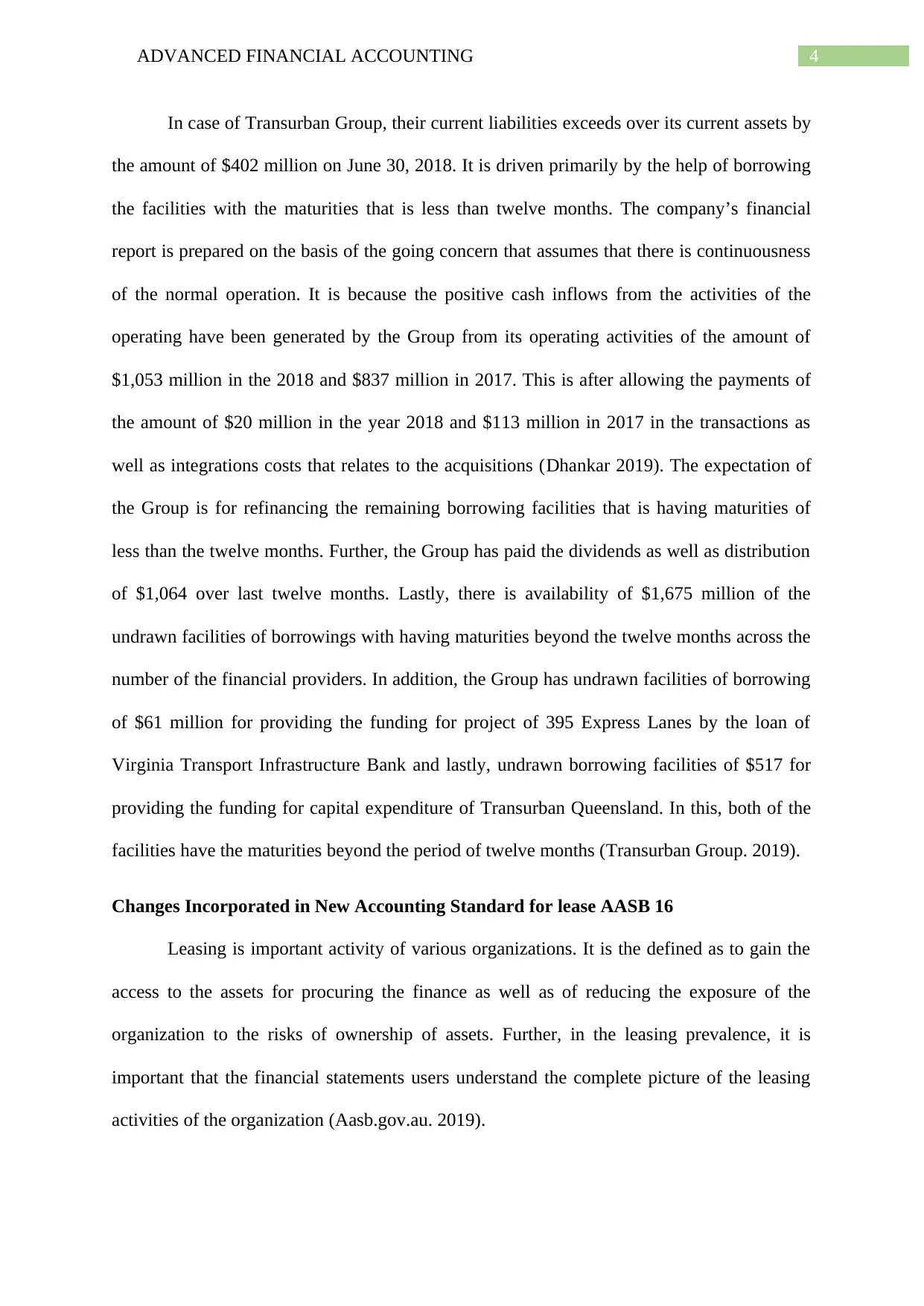
4ADVANCED FINANCIAL ACCOUNTING
In case of Transurban Group, their current liabilities exceeds over its current assets by
the amount of $402 million on June 30, 2018. It is driven primarily by the help of borrowing
the facilities with the maturities that is less than twelve months. The company’s financial
report is prepared on the basis of the going concern that assumes that there is continuousness
of the normal operation. It is because the positive cash inflows from the activities of the
operating have been generated by the Group from its operating activities of the amount of
$1,053 million in the 2018 and $837 million in 2017. This is after allowing the payments of
the amount of $20 million in the year 2018 and $113 million in 2017 in the transactions as
well as integrations costs that relates to the acquisitions (Dhankar 2019). The expectation of
the Group is for refinancing the remaining borrowing facilities that is having maturities of
less than the twelve months. Further, the Group has paid the dividends as well as distribution
of $1,064 over last twelve months. Lastly, there is availability of $1,675 million of the
undrawn facilities of borrowings with having maturities beyond the twelve months across the
number of the financial providers. In addition, the Group has undrawn facilities of borrowing
of $61 million for providing the funding for project of 395 Express Lanes by the loan of
Virginia Transport Infrastructure Bank and lastly, undrawn borrowing facilities of $517 for
providing the funding for capital expenditure of Transurban Queensland. In this, both of the
facilities have the maturities beyond the period of twelve months (Transurban Group. 2019).
Changes Incorporated in New Accounting Standard for lease AASB 16
Leasing is important activity of various organizations. It is the defined as to gain the
access to the assets for procuring the finance as well as of reducing the exposure of the
organization to the risks of ownership of assets. Further, in the leasing prevalence, it is
important that the financial statements users understand the complete picture of the leasing
activities of the organization (Aasb.gov.au. 2019).
In case of Transurban Group, their current liabilities exceeds over its current assets by
the amount of $402 million on June 30, 2018. It is driven primarily by the help of borrowing
the facilities with the maturities that is less than twelve months. The company’s financial
report is prepared on the basis of the going concern that assumes that there is continuousness
of the normal operation. It is because the positive cash inflows from the activities of the
operating have been generated by the Group from its operating activities of the amount of
$1,053 million in the 2018 and $837 million in 2017. This is after allowing the payments of
the amount of $20 million in the year 2018 and $113 million in 2017 in the transactions as
well as integrations costs that relates to the acquisitions (Dhankar 2019). The expectation of
the Group is for refinancing the remaining borrowing facilities that is having maturities of
less than the twelve months. Further, the Group has paid the dividends as well as distribution
of $1,064 over last twelve months. Lastly, there is availability of $1,675 million of the
undrawn facilities of borrowings with having maturities beyond the twelve months across the
number of the financial providers. In addition, the Group has undrawn facilities of borrowing
of $61 million for providing the funding for project of 395 Express Lanes by the loan of
Virginia Transport Infrastructure Bank and lastly, undrawn borrowing facilities of $517 for
providing the funding for capital expenditure of Transurban Queensland. In this, both of the
facilities have the maturities beyond the period of twelve months (Transurban Group. 2019).
Changes Incorporated in New Accounting Standard for lease AASB 16
Leasing is important activity of various organizations. It is the defined as to gain the
access to the assets for procuring the finance as well as of reducing the exposure of the
organization to the risks of ownership of assets. Further, in the leasing prevalence, it is
important that the financial statements users understand the complete picture of the leasing
activities of the organization (Aasb.gov.au. 2019).
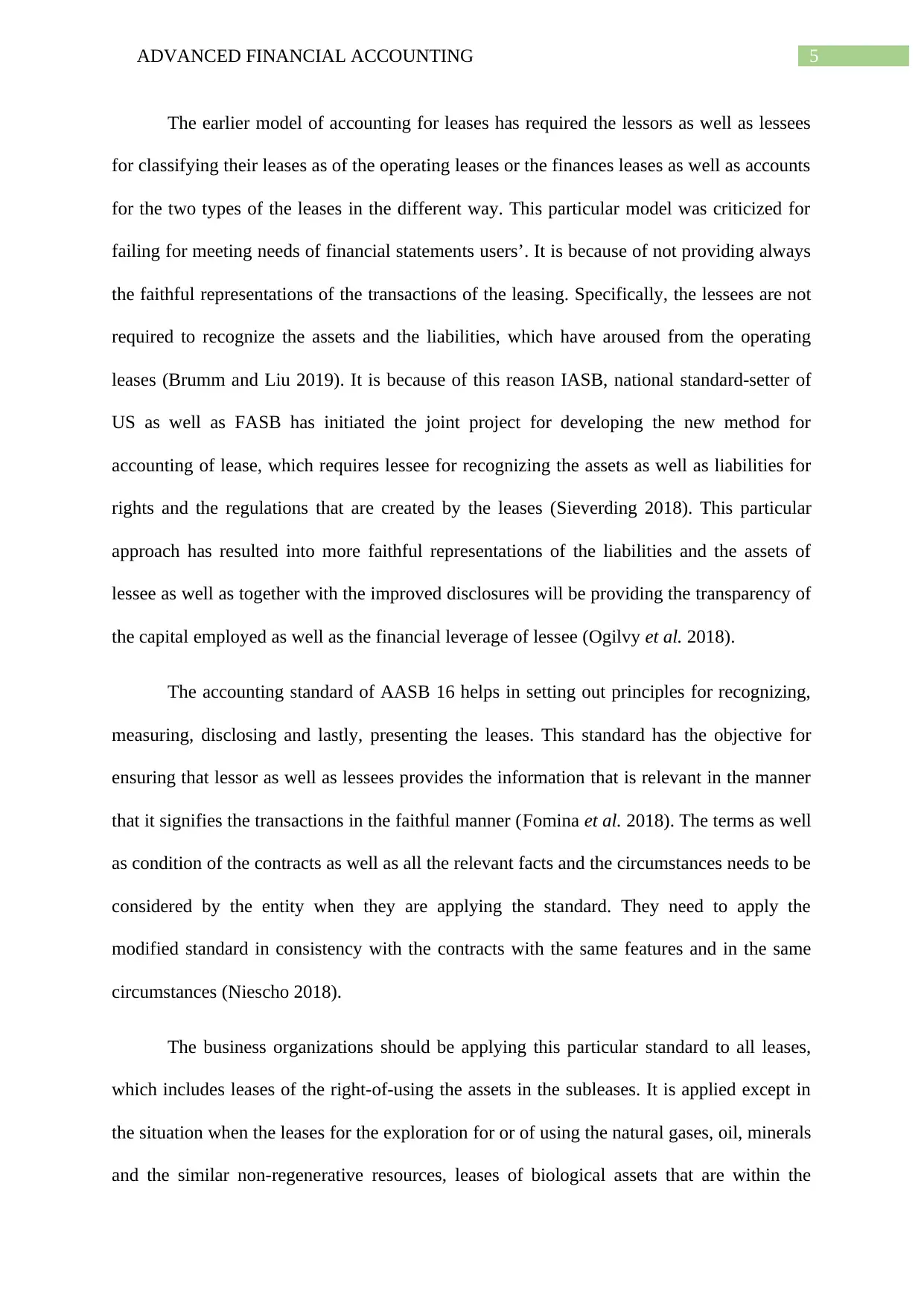
5ADVANCED FINANCIAL ACCOUNTING
The earlier model of accounting for leases has required the lessors as well as lessees
for classifying their leases as of the operating leases or the finances leases as well as accounts
for the two types of the leases in the different way. This particular model was criticized for
failing for meeting needs of financial statements users’. It is because of not providing always
the faithful representations of the transactions of the leasing. Specifically, the lessees are not
required to recognize the assets and the liabilities, which have aroused from the operating
leases (Brumm and Liu 2019). It is because of this reason IASB, national standard-setter of
US as well as FASB has initiated the joint project for developing the new method for
accounting of lease, which requires lessee for recognizing the assets as well as liabilities for
rights and the regulations that are created by the leases (Sieverding 2018). This particular
approach has resulted into more faithful representations of the liabilities and the assets of
lessee as well as together with the improved disclosures will be providing the transparency of
the capital employed as well as the financial leverage of lessee (Ogilvy et al. 2018).
The accounting standard of AASB 16 helps in setting out principles for recognizing,
measuring, disclosing and lastly, presenting the leases. This standard has the objective for
ensuring that lessor as well as lessees provides the information that is relevant in the manner
that it signifies the transactions in the faithful manner (Fomina et al. 2018). The terms as well
as condition of the contracts as well as all the relevant facts and the circumstances needs to be
considered by the entity when they are applying the standard. They need to apply the
modified standard in consistency with the contracts with the same features and in the same
circumstances (Niescho 2018).
The business organizations should be applying this particular standard to all leases,
which includes leases of the right-of-using the assets in the subleases. It is applied except in
the situation when the leases for the exploration for or of using the natural gases, oil, minerals
and the similar non-regenerative resources, leases of biological assets that are within the
The earlier model of accounting for leases has required the lessors as well as lessees
for classifying their leases as of the operating leases or the finances leases as well as accounts
for the two types of the leases in the different way. This particular model was criticized for
failing for meeting needs of financial statements users’. It is because of not providing always
the faithful representations of the transactions of the leasing. Specifically, the lessees are not
required to recognize the assets and the liabilities, which have aroused from the operating
leases (Brumm and Liu 2019). It is because of this reason IASB, national standard-setter of
US as well as FASB has initiated the joint project for developing the new method for
accounting of lease, which requires lessee for recognizing the assets as well as liabilities for
rights and the regulations that are created by the leases (Sieverding 2018). This particular
approach has resulted into more faithful representations of the liabilities and the assets of
lessee as well as together with the improved disclosures will be providing the transparency of
the capital employed as well as the financial leverage of lessee (Ogilvy et al. 2018).
The accounting standard of AASB 16 helps in setting out principles for recognizing,
measuring, disclosing and lastly, presenting the leases. This standard has the objective for
ensuring that lessor as well as lessees provides the information that is relevant in the manner
that it signifies the transactions in the faithful manner (Fomina et al. 2018). The terms as well
as condition of the contracts as well as all the relevant facts and the circumstances needs to be
considered by the entity when they are applying the standard. They need to apply the
modified standard in consistency with the contracts with the same features and in the same
circumstances (Niescho 2018).
The business organizations should be applying this particular standard to all leases,
which includes leases of the right-of-using the assets in the subleases. It is applied except in
the situation when the leases for the exploration for or of using the natural gases, oil, minerals
and the similar non-regenerative resources, leases of biological assets that are within the
⊘ This is a preview!⊘
Do you want full access?
Subscribe today to unlock all pages.

Trusted by 1+ million students worldwide
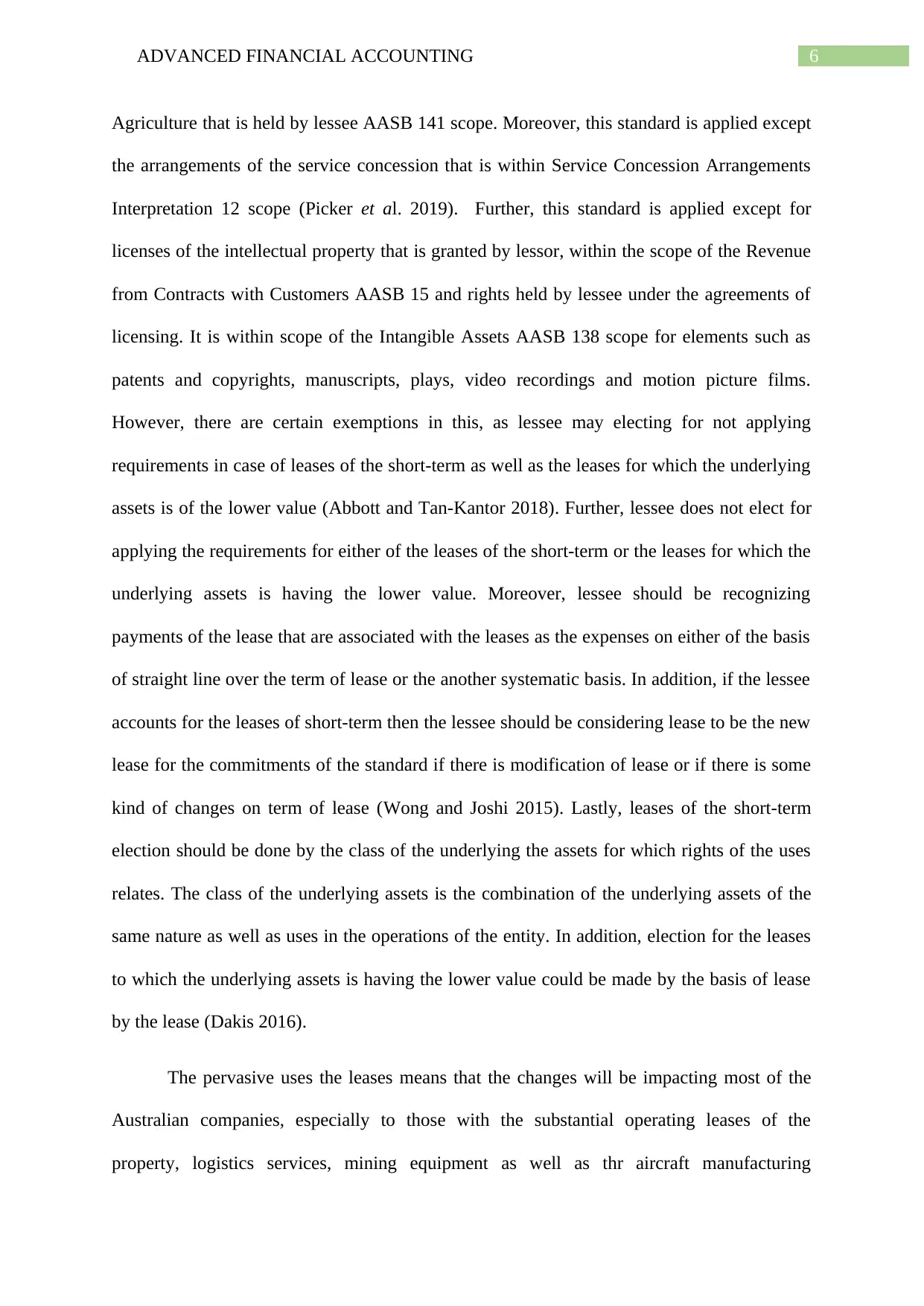
6ADVANCED FINANCIAL ACCOUNTING
Agriculture that is held by lessee AASB 141 scope. Moreover, this standard is applied except
the arrangements of the service concession that is within Service Concession Arrangements
Interpretation 12 scope (Picker et al. 2019). Further, this standard is applied except for
licenses of the intellectual property that is granted by lessor, within the scope of the Revenue
from Contracts with Customers AASB 15 and rights held by lessee under the agreements of
licensing. It is within scope of the Intangible Assets AASB 138 scope for elements such as
patents and copyrights, manuscripts, plays, video recordings and motion picture films.
However, there are certain exemptions in this, as lessee may electing for not applying
requirements in case of leases of the short-term as well as the leases for which the underlying
assets is of the lower value (Abbott and Tan‐Kantor 2018). Further, lessee does not elect for
applying the requirements for either of the leases of the short-term or the leases for which the
underlying assets is having the lower value. Moreover, lessee should be recognizing
payments of the lease that are associated with the leases as the expenses on either of the basis
of straight line over the term of lease or the another systematic basis. In addition, if the lessee
accounts for the leases of short-term then the lessee should be considering lease to be the new
lease for the commitments of the standard if there is modification of lease or if there is some
kind of changes on term of lease (Wong and Joshi 2015). Lastly, leases of the short-term
election should be done by the class of the underlying the assets for which rights of the uses
relates. The class of the underlying assets is the combination of the underlying assets of the
same nature as well as uses in the operations of the entity. In addition, election for the leases
to which the underlying assets is having the lower value could be made by the basis of lease
by the lease (Dakis 2016).
The pervasive uses the leases means that the changes will be impacting most of the
Australian companies, especially to those with the substantial operating leases of the
property, logistics services, mining equipment as well as thr aircraft manufacturing
Agriculture that is held by lessee AASB 141 scope. Moreover, this standard is applied except
the arrangements of the service concession that is within Service Concession Arrangements
Interpretation 12 scope (Picker et al. 2019). Further, this standard is applied except for
licenses of the intellectual property that is granted by lessor, within the scope of the Revenue
from Contracts with Customers AASB 15 and rights held by lessee under the agreements of
licensing. It is within scope of the Intangible Assets AASB 138 scope for elements such as
patents and copyrights, manuscripts, plays, video recordings and motion picture films.
However, there are certain exemptions in this, as lessee may electing for not applying
requirements in case of leases of the short-term as well as the leases for which the underlying
assets is of the lower value (Abbott and Tan‐Kantor 2018). Further, lessee does not elect for
applying the requirements for either of the leases of the short-term or the leases for which the
underlying assets is having the lower value. Moreover, lessee should be recognizing
payments of the lease that are associated with the leases as the expenses on either of the basis
of straight line over the term of lease or the another systematic basis. In addition, if the lessee
accounts for the leases of short-term then the lessee should be considering lease to be the new
lease for the commitments of the standard if there is modification of lease or if there is some
kind of changes on term of lease (Wong and Joshi 2015). Lastly, leases of the short-term
election should be done by the class of the underlying the assets for which rights of the uses
relates. The class of the underlying assets is the combination of the underlying assets of the
same nature as well as uses in the operations of the entity. In addition, election for the leases
to which the underlying assets is having the lower value could be made by the basis of lease
by the lease (Dakis 2016).
The pervasive uses the leases means that the changes will be impacting most of the
Australian companies, especially to those with the substantial operating leases of the
property, logistics services, mining equipment as well as thr aircraft manufacturing
Paraphrase This Document
Need a fresh take? Get an instant paraphrase of this document with our AI Paraphraser
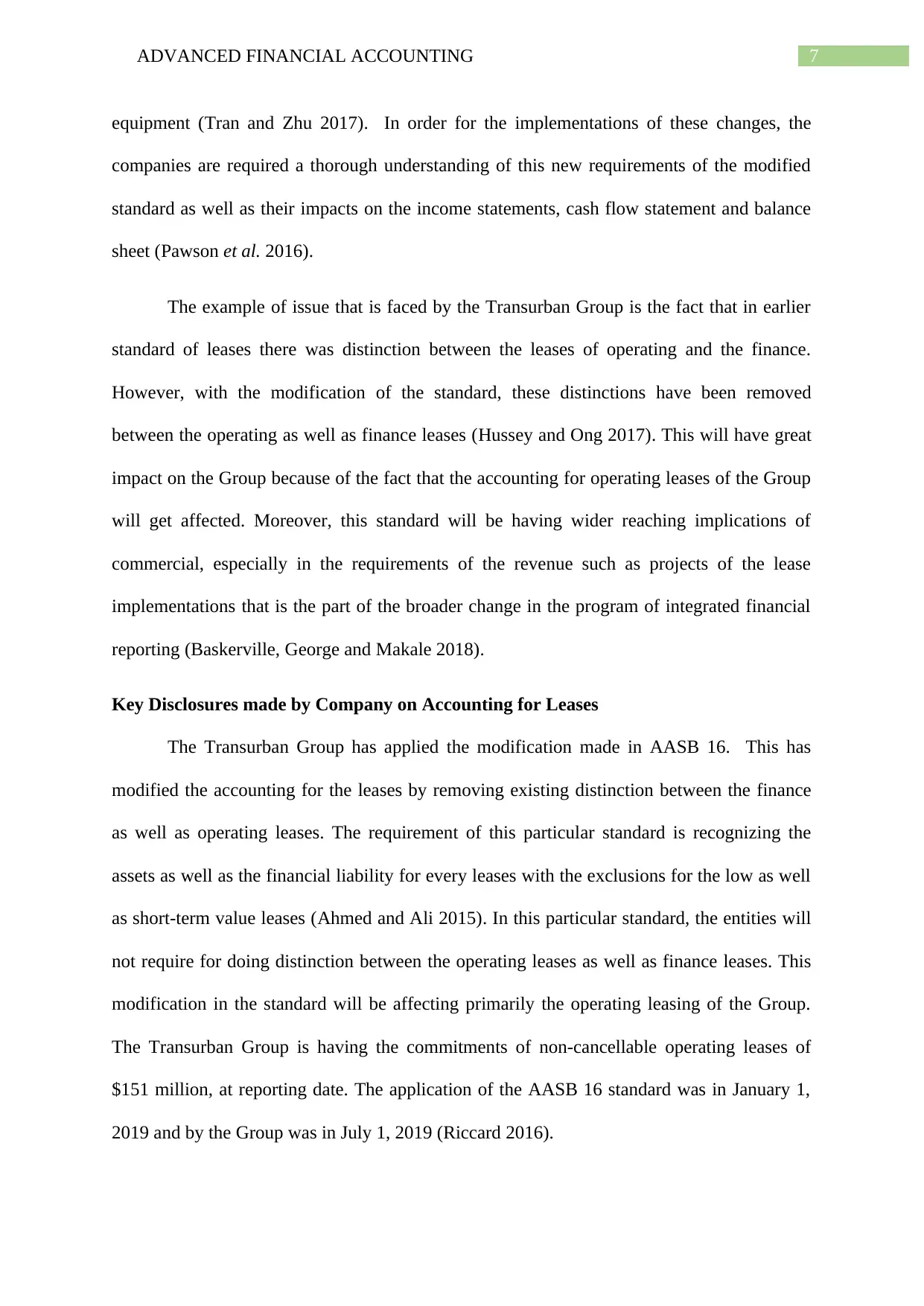
7ADVANCED FINANCIAL ACCOUNTING
equipment (Tran and Zhu 2017). In order for the implementations of these changes, the
companies are required a thorough understanding of this new requirements of the modified
standard as well as their impacts on the income statements, cash flow statement and balance
sheet (Pawson et al. 2016).
The example of issue that is faced by the Transurban Group is the fact that in earlier
standard of leases there was distinction between the leases of operating and the finance.
However, with the modification of the standard, these distinctions have been removed
between the operating as well as finance leases (Hussey and Ong 2017). This will have great
impact on the Group because of the fact that the accounting for operating leases of the Group
will get affected. Moreover, this standard will be having wider reaching implications of
commercial, especially in the requirements of the revenue such as projects of the lease
implementations that is the part of the broader change in the program of integrated financial
reporting (Baskerville, George and Makale 2018).
Key Disclosures made by Company on Accounting for Leases
The Transurban Group has applied the modification made in AASB 16. This has
modified the accounting for the leases by removing existing distinction between the finance
as well as operating leases. The requirement of this particular standard is recognizing the
assets as well as the financial liability for every leases with the exclusions for the low as well
as short-term value leases (Ahmed and Ali 2015). In this particular standard, the entities will
not require for doing distinction between the operating leases as well as finance leases. This
modification in the standard will be affecting primarily the operating leasing of the Group.
The Transurban Group is having the commitments of non-cancellable operating leases of
$151 million, at reporting date. The application of the AASB 16 standard was in January 1,
2019 and by the Group was in July 1, 2019 (Riccard 2016).
equipment (Tran and Zhu 2017). In order for the implementations of these changes, the
companies are required a thorough understanding of this new requirements of the modified
standard as well as their impacts on the income statements, cash flow statement and balance
sheet (Pawson et al. 2016).
The example of issue that is faced by the Transurban Group is the fact that in earlier
standard of leases there was distinction between the leases of operating and the finance.
However, with the modification of the standard, these distinctions have been removed
between the operating as well as finance leases (Hussey and Ong 2017). This will have great
impact on the Group because of the fact that the accounting for operating leases of the Group
will get affected. Moreover, this standard will be having wider reaching implications of
commercial, especially in the requirements of the revenue such as projects of the lease
implementations that is the part of the broader change in the program of integrated financial
reporting (Baskerville, George and Makale 2018).
Key Disclosures made by Company on Accounting for Leases
The Transurban Group has applied the modification made in AASB 16. This has
modified the accounting for the leases by removing existing distinction between the finance
as well as operating leases. The requirement of this particular standard is recognizing the
assets as well as the financial liability for every leases with the exclusions for the low as well
as short-term value leases (Ahmed and Ali 2015). In this particular standard, the entities will
not require for doing distinction between the operating leases as well as finance leases. This
modification in the standard will be affecting primarily the operating leasing of the Group.
The Transurban Group is having the commitments of non-cancellable operating leases of
$151 million, at reporting date. The application of the AASB 16 standard was in January 1,
2019 and by the Group was in July 1, 2019 (Riccard 2016).
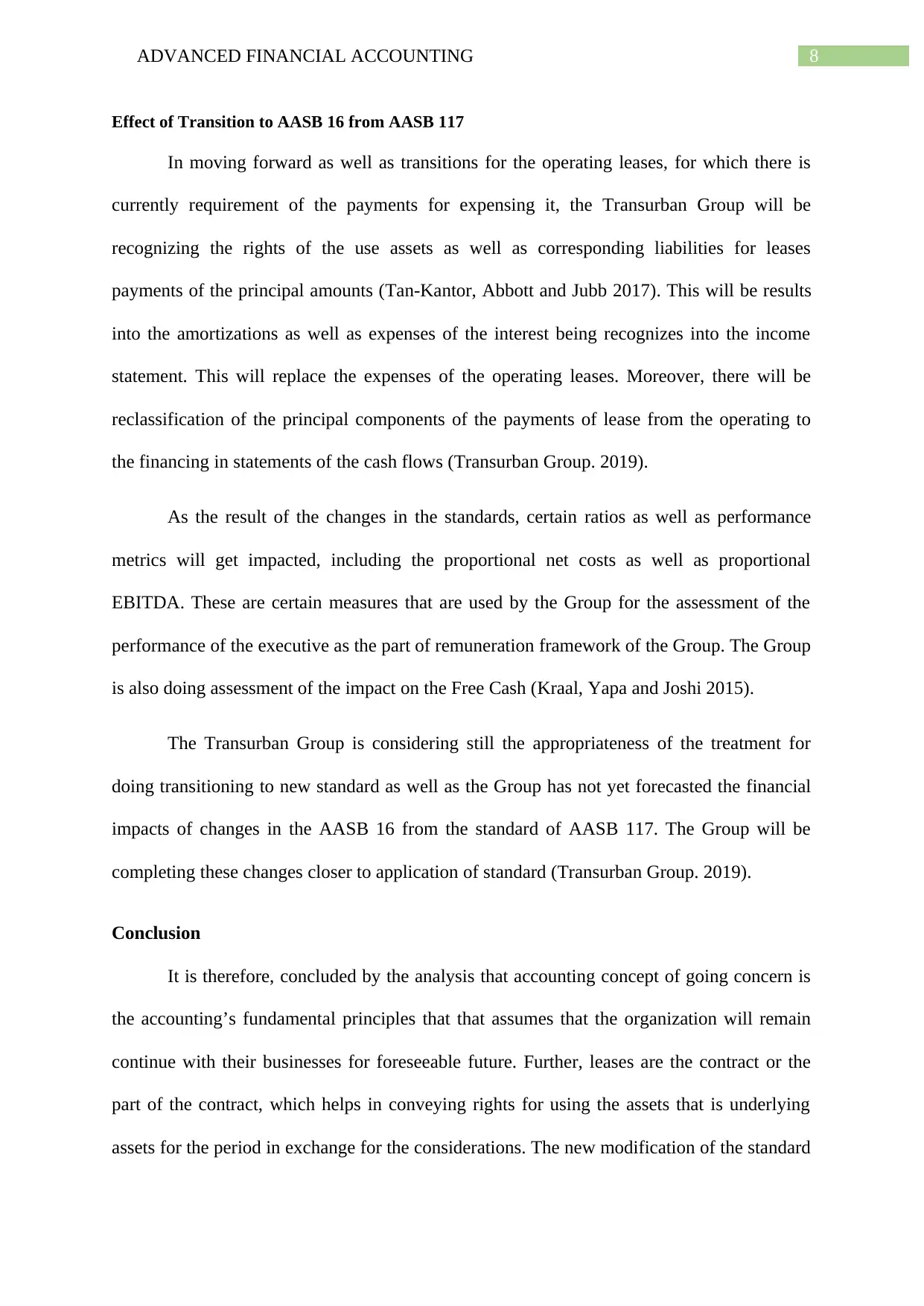
8ADVANCED FINANCIAL ACCOUNTING
Effect of Transition to AASB 16 from AASB 117
In moving forward as well as transitions for the operating leases, for which there is
currently requirement of the payments for expensing it, the Transurban Group will be
recognizing the rights of the use assets as well as corresponding liabilities for leases
payments of the principal amounts (Tan‐Kantor, Abbott and Jubb 2017). This will be results
into the amortizations as well as expenses of the interest being recognizes into the income
statement. This will replace the expenses of the operating leases. Moreover, there will be
reclassification of the principal components of the payments of lease from the operating to
the financing in statements of the cash flows (Transurban Group. 2019).
As the result of the changes in the standards, certain ratios as well as performance
metrics will get impacted, including the proportional net costs as well as proportional
EBITDA. These are certain measures that are used by the Group for the assessment of the
performance of the executive as the part of remuneration framework of the Group. The Group
is also doing assessment of the impact on the Free Cash (Kraal, Yapa and Joshi 2015).
The Transurban Group is considering still the appropriateness of the treatment for
doing transitioning to new standard as well as the Group has not yet forecasted the financial
impacts of changes in the AASB 16 from the standard of AASB 117. The Group will be
completing these changes closer to application of standard (Transurban Group. 2019).
Conclusion
It is therefore, concluded by the analysis that accounting concept of going concern is
the accounting’s fundamental principles that that assumes that the organization will remain
continue with their businesses for foreseeable future. Further, leases are the contract or the
part of the contract, which helps in conveying rights for using the assets that is underlying
assets for the period in exchange for the considerations. The new modification of the standard
Effect of Transition to AASB 16 from AASB 117
In moving forward as well as transitions for the operating leases, for which there is
currently requirement of the payments for expensing it, the Transurban Group will be
recognizing the rights of the use assets as well as corresponding liabilities for leases
payments of the principal amounts (Tan‐Kantor, Abbott and Jubb 2017). This will be results
into the amortizations as well as expenses of the interest being recognizes into the income
statement. This will replace the expenses of the operating leases. Moreover, there will be
reclassification of the principal components of the payments of lease from the operating to
the financing in statements of the cash flows (Transurban Group. 2019).
As the result of the changes in the standards, certain ratios as well as performance
metrics will get impacted, including the proportional net costs as well as proportional
EBITDA. These are certain measures that are used by the Group for the assessment of the
performance of the executive as the part of remuneration framework of the Group. The Group
is also doing assessment of the impact on the Free Cash (Kraal, Yapa and Joshi 2015).
The Transurban Group is considering still the appropriateness of the treatment for
doing transitioning to new standard as well as the Group has not yet forecasted the financial
impacts of changes in the AASB 16 from the standard of AASB 117. The Group will be
completing these changes closer to application of standard (Transurban Group. 2019).
Conclusion
It is therefore, concluded by the analysis that accounting concept of going concern is
the accounting’s fundamental principles that that assumes that the organization will remain
continue with their businesses for foreseeable future. Further, leases are the contract or the
part of the contract, which helps in conveying rights for using the assets that is underlying
assets for the period in exchange for the considerations. The new modification of the standard
⊘ This is a preview!⊘
Do you want full access?
Subscribe today to unlock all pages.

Trusted by 1+ million students worldwide
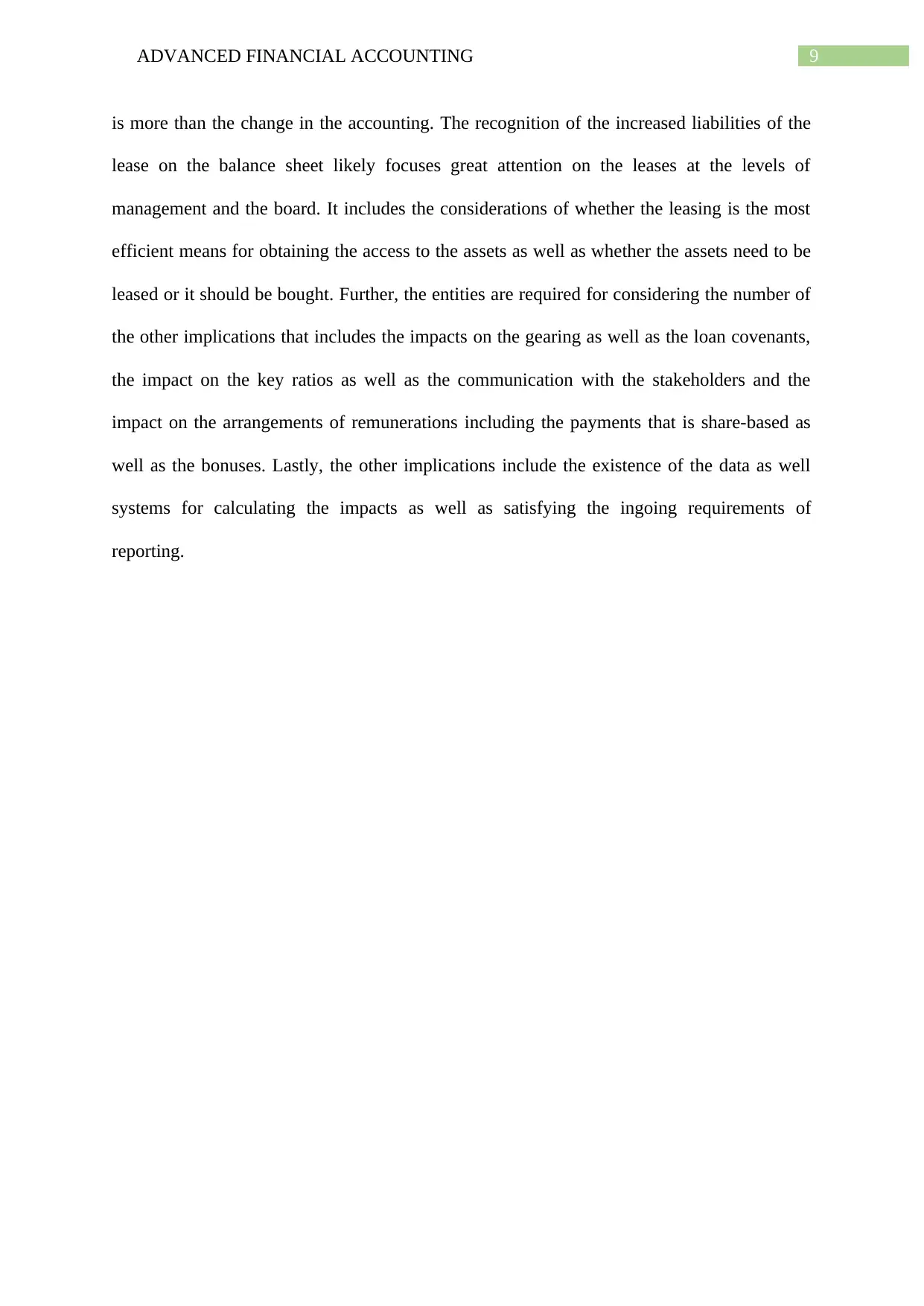
9ADVANCED FINANCIAL ACCOUNTING
is more than the change in the accounting. The recognition of the increased liabilities of the
lease on the balance sheet likely focuses great attention on the leases at the levels of
management and the board. It includes the considerations of whether the leasing is the most
efficient means for obtaining the access to the assets as well as whether the assets need to be
leased or it should be bought. Further, the entities are required for considering the number of
the other implications that includes the impacts on the gearing as well as the loan covenants,
the impact on the key ratios as well as the communication with the stakeholders and the
impact on the arrangements of remunerations including the payments that is share-based as
well as the bonuses. Lastly, the other implications include the existence of the data as well
systems for calculating the impacts as well as satisfying the ingoing requirements of
reporting.
is more than the change in the accounting. The recognition of the increased liabilities of the
lease on the balance sheet likely focuses great attention on the leases at the levels of
management and the board. It includes the considerations of whether the leasing is the most
efficient means for obtaining the access to the assets as well as whether the assets need to be
leased or it should be bought. Further, the entities are required for considering the number of
the other implications that includes the impacts on the gearing as well as the loan covenants,
the impact on the key ratios as well as the communication with the stakeholders and the
impact on the arrangements of remunerations including the payments that is share-based as
well as the bonuses. Lastly, the other implications include the existence of the data as well
systems for calculating the impacts as well as satisfying the ingoing requirements of
reporting.
Paraphrase This Document
Need a fresh take? Get an instant paraphrase of this document with our AI Paraphraser
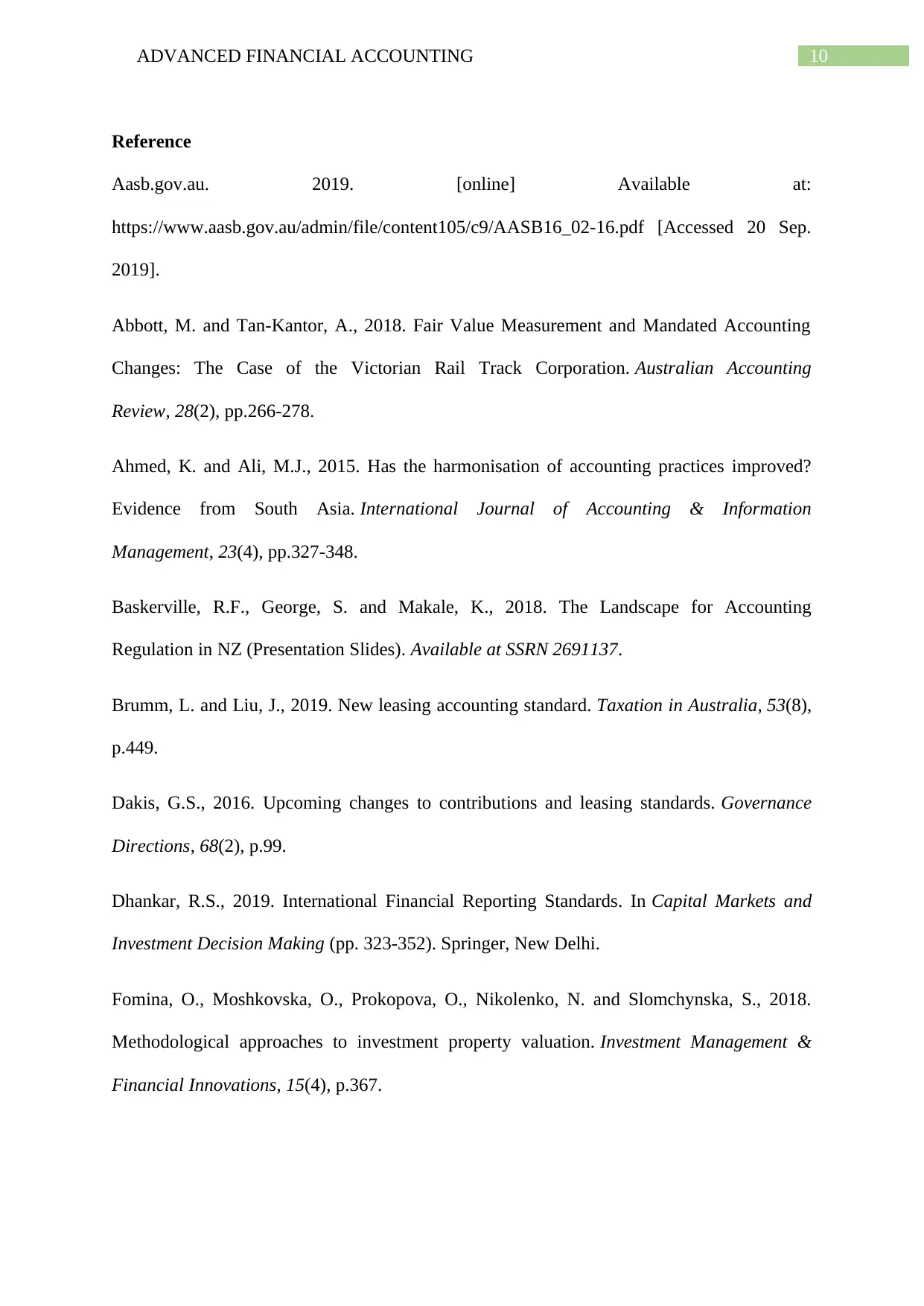
10ADVANCED FINANCIAL ACCOUNTING
Reference
Aasb.gov.au. 2019. [online] Available at:
https://www.aasb.gov.au/admin/file/content105/c9/AASB16_02-16.pdf [Accessed 20 Sep.
2019].
Abbott, M. and Tan‐Kantor, A., 2018. Fair Value Measurement and Mandated Accounting
Changes: The Case of the Victorian Rail Track Corporation. Australian Accounting
Review, 28(2), pp.266-278.
Ahmed, K. and Ali, M.J., 2015. Has the harmonisation of accounting practices improved?
Evidence from South Asia. International Journal of Accounting & Information
Management, 23(4), pp.327-348.
Baskerville, R.F., George, S. and Makale, K., 2018. The Landscape for Accounting
Regulation in NZ (Presentation Slides). Available at SSRN 2691137.
Brumm, L. and Liu, J., 2019. New leasing accounting standard. Taxation in Australia, 53(8),
p.449.
Dakis, G.S., 2016. Upcoming changes to contributions and leasing standards. Governance
Directions, 68(2), p.99.
Dhankar, R.S., 2019. International Financial Reporting Standards. In Capital Markets and
Investment Decision Making (pp. 323-352). Springer, New Delhi.
Fomina, O., Moshkovska, O., Prokopova, O., Nikolenko, N. and Slomchynska, S., 2018.
Methodological approaches to investment property valuation. Investment Management &
Financial Innovations, 15(4), p.367.
Reference
Aasb.gov.au. 2019. [online] Available at:
https://www.aasb.gov.au/admin/file/content105/c9/AASB16_02-16.pdf [Accessed 20 Sep.
2019].
Abbott, M. and Tan‐Kantor, A., 2018. Fair Value Measurement and Mandated Accounting
Changes: The Case of the Victorian Rail Track Corporation. Australian Accounting
Review, 28(2), pp.266-278.
Ahmed, K. and Ali, M.J., 2015. Has the harmonisation of accounting practices improved?
Evidence from South Asia. International Journal of Accounting & Information
Management, 23(4), pp.327-348.
Baskerville, R.F., George, S. and Makale, K., 2018. The Landscape for Accounting
Regulation in NZ (Presentation Slides). Available at SSRN 2691137.
Brumm, L. and Liu, J., 2019. New leasing accounting standard. Taxation in Australia, 53(8),
p.449.
Dakis, G.S., 2016. Upcoming changes to contributions and leasing standards. Governance
Directions, 68(2), p.99.
Dhankar, R.S., 2019. International Financial Reporting Standards. In Capital Markets and
Investment Decision Making (pp. 323-352). Springer, New Delhi.
Fomina, O., Moshkovska, O., Prokopova, O., Nikolenko, N. and Slomchynska, S., 2018.
Methodological approaches to investment property valuation. Investment Management &
Financial Innovations, 15(4), p.367.
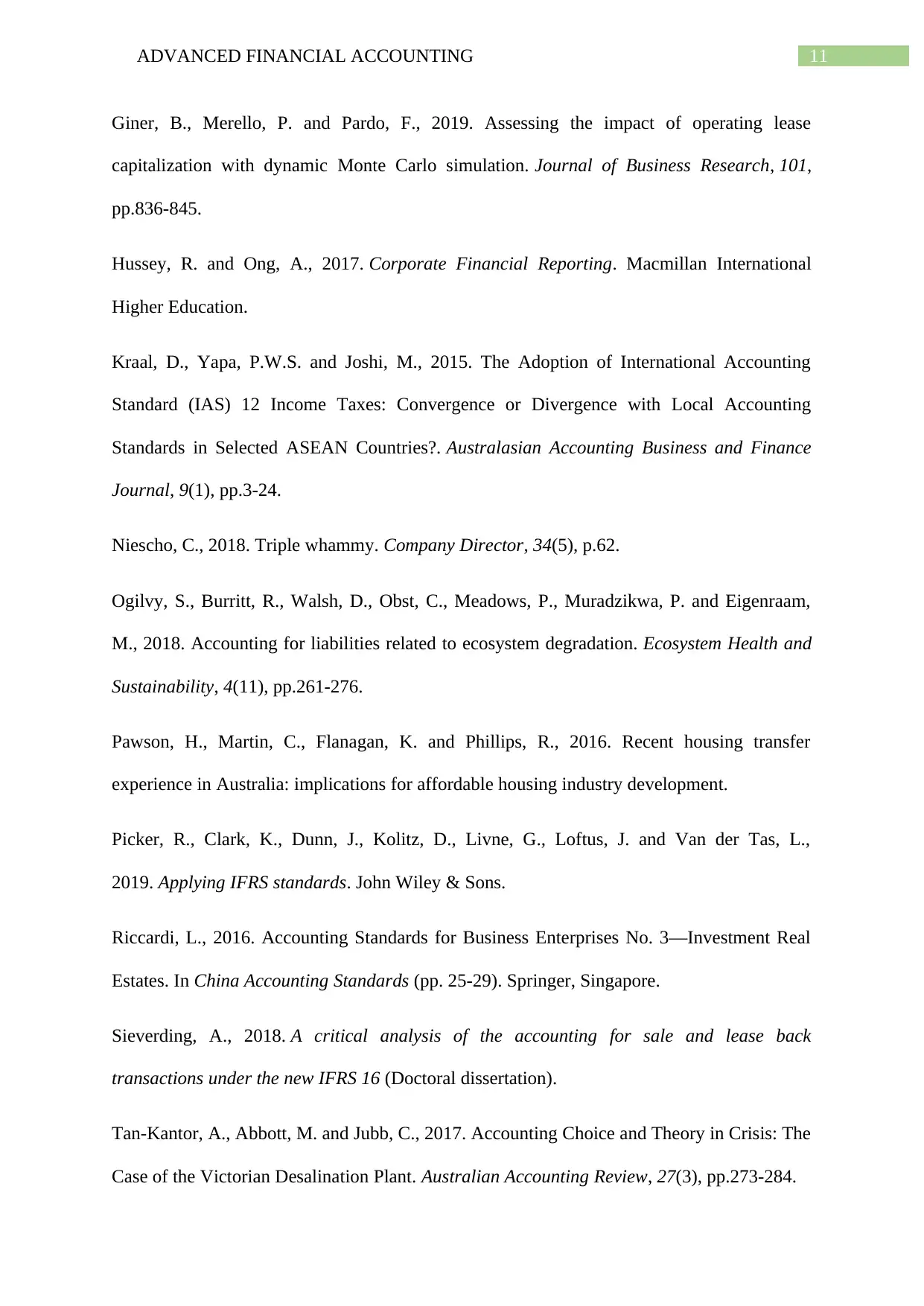
11ADVANCED FINANCIAL ACCOUNTING
Giner, B., Merello, P. and Pardo, F., 2019. Assessing the impact of operating lease
capitalization with dynamic Monte Carlo simulation. Journal of Business Research, 101,
pp.836-845.
Hussey, R. and Ong, A., 2017. Corporate Financial Reporting. Macmillan International
Higher Education.
Kraal, D., Yapa, P.W.S. and Joshi, M., 2015. The Adoption of International Accounting
Standard (IAS) 12 Income Taxes: Convergence or Divergence with Local Accounting
Standards in Selected ASEAN Countries?. Australasian Accounting Business and Finance
Journal, 9(1), pp.3-24.
Niescho, C., 2018. Triple whammy. Company Director, 34(5), p.62.
Ogilvy, S., Burritt, R., Walsh, D., Obst, C., Meadows, P., Muradzikwa, P. and Eigenraam,
M., 2018. Accounting for liabilities related to ecosystem degradation. Ecosystem Health and
Sustainability, 4(11), pp.261-276.
Pawson, H., Martin, C., Flanagan, K. and Phillips, R., 2016. Recent housing transfer
experience in Australia: implications for affordable housing industry development.
Picker, R., Clark, K., Dunn, J., Kolitz, D., Livne, G., Loftus, J. and Van der Tas, L.,
2019. Applying IFRS standards. John Wiley & Sons.
Riccardi, L., 2016. Accounting Standards for Business Enterprises No. 3—Investment Real
Estates. In China Accounting Standards (pp. 25-29). Springer, Singapore.
Sieverding, A., 2018. A critical analysis of the accounting for sale and lease back
transactions under the new IFRS 16 (Doctoral dissertation).
Tan‐Kantor, A., Abbott, M. and Jubb, C., 2017. Accounting Choice and Theory in Crisis: The
Case of the Victorian Desalination Plant. Australian Accounting Review, 27(3), pp.273-284.
Giner, B., Merello, P. and Pardo, F., 2019. Assessing the impact of operating lease
capitalization with dynamic Monte Carlo simulation. Journal of Business Research, 101,
pp.836-845.
Hussey, R. and Ong, A., 2017. Corporate Financial Reporting. Macmillan International
Higher Education.
Kraal, D., Yapa, P.W.S. and Joshi, M., 2015. The Adoption of International Accounting
Standard (IAS) 12 Income Taxes: Convergence or Divergence with Local Accounting
Standards in Selected ASEAN Countries?. Australasian Accounting Business and Finance
Journal, 9(1), pp.3-24.
Niescho, C., 2018. Triple whammy. Company Director, 34(5), p.62.
Ogilvy, S., Burritt, R., Walsh, D., Obst, C., Meadows, P., Muradzikwa, P. and Eigenraam,
M., 2018. Accounting for liabilities related to ecosystem degradation. Ecosystem Health and
Sustainability, 4(11), pp.261-276.
Pawson, H., Martin, C., Flanagan, K. and Phillips, R., 2016. Recent housing transfer
experience in Australia: implications for affordable housing industry development.
Picker, R., Clark, K., Dunn, J., Kolitz, D., Livne, G., Loftus, J. and Van der Tas, L.,
2019. Applying IFRS standards. John Wiley & Sons.
Riccardi, L., 2016. Accounting Standards for Business Enterprises No. 3—Investment Real
Estates. In China Accounting Standards (pp. 25-29). Springer, Singapore.
Sieverding, A., 2018. A critical analysis of the accounting for sale and lease back
transactions under the new IFRS 16 (Doctoral dissertation).
Tan‐Kantor, A., Abbott, M. and Jubb, C., 2017. Accounting Choice and Theory in Crisis: The
Case of the Victorian Desalination Plant. Australian Accounting Review, 27(3), pp.273-284.
⊘ This is a preview!⊘
Do you want full access?
Subscribe today to unlock all pages.

Trusted by 1+ million students worldwide
1 out of 13
Related Documents
Your All-in-One AI-Powered Toolkit for Academic Success.
+13062052269
info@desklib.com
Available 24*7 on WhatsApp / Email
![[object Object]](/_next/static/media/star-bottom.7253800d.svg)
Unlock your academic potential
Copyright © 2020–2025 A2Z Services. All Rights Reserved. Developed and managed by ZUCOL.




